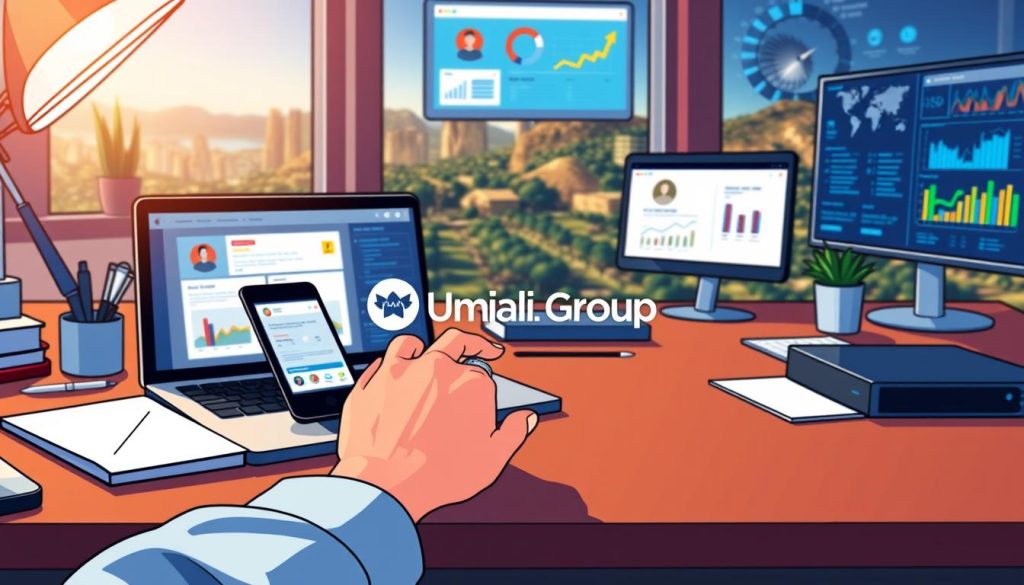Did you know that 54% of consumers now trust digital feedback more than personal recommendations from friends and family? This surprising statistic reveals a fundamental shift in how people make purchasing decisions today.
Welcome to your ultimate guide on mastering customer feedback across digital platforms. This systematic approach to handling customer opinions can dramatically transform how your brand is perceived in the marketplace.
Effective handling of customer feedback differs significantly from broader reputation efforts. It focuses specifically on collecting, monitoring, responding to, and leveraging what people say about your company across various platforms.
For any organization, this practice has become an essential component of marketing and customer service strategy. When done correctly, it builds trust with potential buyers and improves your visibility in search results.
Throughout this comprehensive guide, we’ll provide actionable strategies and real-world examples. You’ll learn how to turn customer opinions into a competitive advantage, whether you’re a small local shop or a multi-location enterprise.
Table of Contents
Key Takeaways
- Over half of consumers trust digital feedback more than personal recommendations
- Systematic handling of customer opinions transforms brand perception
- This approach focuses on collecting, monitoring, and responding to feedback
- It builds trust with potential customers and improves search visibility
- Effective strategies turn customer opinions into competitive advantages
- Applies to businesses of all sizes, from local shops to large enterprises
- Creates a systematic approach to managing your digital presence
Introduction to Online Reviews and Reputation
The shift toward digital word-of-mouth has transformed how consumers evaluate businesses before making choices. Public testimonials now serve as the modern equivalent of personal recommendations.
What Are Online Reviews?
Online reviews are public testimonials where customers share their honest experiences. They provide valuable information about products, services, and overall brand interactions.
These evaluations appear on various platforms like Google, Facebook, and industry-specific sites. They give potential buyers a transparent window into what they can expect.
The Impact on Your Business Reputation
The effect on your business reputation is massive. Research shows that 96% of consumers read online reviews when browsing for local businesses.
Only 3% of shoppers will use a business with two-star reviews or lower. This demonstrates how negative feedback can directly cost you customers and revenue. Understanding effective review strategies becomes essential for maintaining a positive reputation.
Understanding « online reviews management » as a Strategy
Many business owners mistakenly believe that handling customer feedback is simply about damage control. In reality, it represents a sophisticated management strategy that can significantly impact your bottom line.
This systematic approach transforms random customer opinions into valuable business intelligence. When implemented correctly, it becomes a powerful tool for growth.
Defining the Key Components
Effective review management operates through four essential pillars. The first involves generating feedback through automated requests across multiple channels.
Monitoring comes next, using centralized dashboards to track what customers say. Professional responses to all feedback demonstrate your commitment to customer satisfaction.
Finally, marketing positive testimonials across your channels turns happy customers into your best advocates. This complete process creates a cycle of continuous improvement.
Differences Between Review and Reputation Management
While often used interchangeably, these two approaches serve distinct purposes. Review management specifically focuses on collecting and responding to customer testimonials.
Reputation management takes a broader view, encompassing your entire brand perception. It includes media relations, crisis plans, and corporate culture.
Think of review handling as a crucial component within your larger reputation strategy. Both work together to build trust and credibility with your audience.
The Role of Customer Feedback in Building Trust
In today’s marketplace, genuine trust emerges not from marketing claims but from the collective voice of your customers. This authentic foundation separates successful businesses from those struggling to connect with their audience.
When you actively listen to and address customer feedback, you demonstrate commitment to continuous improvement. This approach resonates deeply with consumers who want to feel heard and valued.
Enhancing Customer Experience
Customer feedback creates a powerful cycle of improvement. Satisfied clients leave positive testimonials that attract new customers, who then contribute their own perspectives.
This continuous loop elevates your service quality and reputation. Each piece of feedback becomes an opportunity to refine the customer experience.
| Feedback Type | Impact on Service | Customer Response | Business Outcome |
|---|---|---|---|
| Positive Comments | Validates current practices | Increased loyalty | Higher retention rates |
| Constructive Criticism | Identifies improvement areas | Appreciation for responsiveness | Enhanced reputation |
| Specific Complaints | Targets immediate issues | Satisfaction with resolution | Prevented customer loss |
Social Proof and Consumer Decision-Making
Social proof represents a fundamental psychological principle where people look to others’ opinions to guide their choices. Customer reviews provide exactly this type of validation that influences buying behavior.
Research reveals that 85% of consumers actively avoided businesses with negative feedback in the past year.
Positive customer reviews function as organic social proof that outperforms traditional advertising. They come from impartial third parties without financial motivation, making them incredibly persuasive.
Even responding constructively to negative feedback builds trust by demonstrating authenticity. It shows potential customers that you take responsibility and actively work to resolve issues. Understanding effective strategies becomes essential for maintaining this positive cycle.
Monitoring and Analyzing Online Reviews

The ability to track and analyze customer opinions across various platforms separates proactive businesses from reactive ones. Effective monitoring provides valuable insights into customer satisfaction and brand perception.
Businesses must monitor feedback across multiple touchpoints where customers share their experiences. This includes major platforms like Google Business Profile, which accounts for 90% of all digital feedback.
Essential Tools and Platforms
Comprehensive monitoring requires specialized tools that aggregate data from multiple sources. Platforms like Birdeye centralize feedback from dozens of review sites into one dashboard.
Ecommerce businesses face unique challenges tracking reviews across their stores and marketplaces. Tools like Yotpo integrate directly with shopping platforms to automate the review request process.
For businesses on limited budgets, free options like Google Alerts provide basic monitoring capabilities. These tools help track mentions of your business name across the web.
Setting Up Effective Alerts and Dashboards
Immediate notifications ensure you never miss important customer feedback. Setting up alerts allows you to respond within the critical 24-48 hour window.
Advanced platforms offer analytics dashboards that track sentiment trends over time. These tools identify recurring themes in customer feedback across different platforms.
Visual content from real customers provides compelling social proof. Specialized tools support photo and video reviews, enhancing the authenticity of customer testimonials.
Effective Techniques for Generating More Reviews
Businesses often overlook the simplest method for gathering customer testimonials: direct requests. Most satisfied customers want to share their experiences but need clear guidance on how to do so.
Automated systems make this process incredibly efficient. Set up email or SMS messages that thank customers and gently ask for feedback shortly after their purchase.
Automated Review Requests and Follow-Ups
Timing plays a crucial role in successful review generation. Send your request immediately after successful transactions or positive service interactions.
Customers are most motivated to share feedback when their experience is fresh. Automated follow-ups catch those who intended to review but simply forgot.
| Request Method | Best Timing | Response Rate | Implementation Effort |
|---|---|---|---|
| Email Automation | Within 24 hours of purchase | High | Low |
| SMS Messages | Right after service completion | Very High | Medium |
| QR Code Cards | At point of sale | Medium | Low |
| Tablet Kiosks | Before customers leave | High | High |
Incentivizing and Encouraging Customer Feedback
Make the process frictionless with one-click links straight to review forms. Physical reminders work wonders for brick-and-mortar locations.
Hand out cards with QR codes at checkout or display TripAdvisor stickers in windows. These subtle prompts encourage customers to leave valuable feedback without extra staff time.
Best Practices for Responding to Reviews
The art of crafting thoughtful responses to customer opinions has become a critical business skill. According to Birdeye’s 2024 study, 63% of reviews now receive responses, showing a 10% increase from the previous year.
Creating Personalized Response Templates
Speed matters when addressing customer feedback. Aim to reply within 24 hours to show you value their input. Create base templates for different types of feedback to streamline your process.
Always customize each response with the reviewer’s name and specific details they mentioned. For positive comments, thank them personally and reference what they enjoyed. This personal touch makes customers feel genuinely appreciated.
Handling Negative Feedback Constructively
When facing critical feedback, acknowledge the concern immediately in your first sentence. Take responsibility without making excuses or being defensive. Offer a concrete solution like a refund or replacement.
Provide direct contact information to move the conversation offline. This shows other readers your commitment to resolution while preventing public disputes. Your professional handling of negative situations demonstrates authenticity to all potential customers.
Leveraging Social Media and PR for Reputation Enhancement
Social platforms now serve as the frontline where brand reputations are built, challenged, and ultimately strengthened. These digital spaces have transformed into essential discovery channels where consumers research products and make purchasing decisions.
Your social media strategy should actively incorporate customer feedback rather than just monitor conversations. Create engaging marketing content by sharing testimonials as Instagram highlights or featuring customer stories in regular posts.
Integrating Reviews into Your Social Media Strategy
Tools like HubSpot and Hootsuite help track brand mentions across platforms. This allows timely responses to both positive and negative comments before they gain momentum.
Transform customer feedback into compelling social proof through creative content approaches. Regular features like « Review of the Week » keep your audience engaged while building credibility.
| Platform | Primary Use | Response Time | Content Type |
|---|---|---|---|
| Customer service | Within hours | Testimonial graphics | |
| Visual storytelling | 24 hours | Story highlights | |
| Quick updates | Immediate | Quote tweets | |
| Professional image | Business day | Case studies |
Utilizing PR for Crisis and Brand Image Management
Public relations plays a crucial role in proactive reputation management. Instead of just reacting to feedback, create positive coverage through event sponsorships and business awards.
Crisis preparation is essential for protecting your business reputation. Develop response protocols for different scenarios, learning from companies like KFC and Starbucks who turned challenges into opportunities.
Free resources from organizations like the Chartered Institute of Public Relations provide actionable frameworks. These help businesses develop professional media relations without expensive consultants.
Developing a Comprehensive Review Management Strategy

Building a structured approach to customer feedback transforms random opinions into actionable business intelligence. This systematic framework ensures every voice contributes meaningfully to your growth.
Start by researching your current standing across different platforms. Understand what customers truly think about your products and services.
Setting Measurable Goals and Responsibilities
Define clear objectives that align with your overall business strategy. Aim for specific targets like improving star ratings or response times.
Assign roles carefully, especially for multi-location operations. Local managers handle daily responses while corporate teams track performance data.
Tracking Performance Across Multiple Platforms
Use centralized dashboards to monitor feedback from various sources. This helps identify trends and compare location performance.
Regular analysis reveals patterns that inform improvements. Customer insights drive meaningful changes across your organization.
Industry Case Studies and Success Examples
Seeing real results from other companies provides the best proof that review strategies work. These real-world examples demonstrate how systematic approaches deliver measurable growth.
Lessons from Multi-location Businesses
Companies with multiple locations face unique challenges. They must coordinate feedback across many sites while maintaining consistent quality.
American Pacific Mortgage shows what long-term commitment achieves. Their CMO Melissa Wright shares their impressive journey.
« When we partnered with Birdeye, we had 13,000 reviews. Now we have 135,000 reviews across all locations. That’s 800% growth. »
Real-world Success Stories and Tactics
Different industries reveal common success factors. The right tools make feedback handling efficient rather than burdensome.
Valley Vet Care’s experience highlights this transformation. Their operations manager notes the practical benefits.
| Business Type | Challenge | Solution | Outcome |
|---|---|---|---|
| Multi-location Mortgage | Coordinating thousands of feedback points | Dedicated platform partnership | 800% review growth |
| Veterinary Care Chain | Response consistency across locations | Centralized monitoring system | Timely, appropriate responses |
| Counseling Practice | Organic review generation limitations | Systematic request methodology | 1900% increase in two years |
Genesis Counseling’s growth from 50 to 950 reviews proves systematic approaches outperform passive methods. These examples show that dedicated resources and consistent execution create competitive advantages that are difficult to replicate.
Conclusion
Think of your online reputation as a living, breathing entity that requires daily attention and care. It grows stronger with each positive interaction and thoughtful response to customer feedback.
The benefits of systematic feedback handling are clear: better search visibility, stronger trust with potential customers, and valuable insights for improving your customer experience. This approach transforms casual opinions into strategic advantages for businesses of all sizes.
True success comes from making this practice part of your daily operations. When you consistently deliver excellent service and actively manage feedback, you build a reputation that attracts loyal customers and drives long-term growth.
FAQ
What exactly is online review management?
It’s a proactive process for handling the feedback customers leave on sites like Google and Yelp. This strategy involves monitoring, responding to, and learning from this content to build a stronger brand image and improve the overall customer experience.
Why is responding to customer feedback so important?
Responding shows you value your customers’ opinions. A thoughtful reply to a positive comment builds loyalty, and addressing a negative one professionally can turn a critic into a fan. It’s a powerful way to demonstrate your commitment to great service.
How can I get more customers to leave reviews?
Make it easy! Send a polite follow-up email or text after a purchase. You can also include links to your profiles on your website and receipts. Some businesses gently incentivize feedback, but always follow each platform’s specific guidelines.
What’s the best way to handle a bad review?
Stay calm and professional. Thank the person for their input, apologize for their poor experience, and offer to take the conversation offline to resolve the issue. This shows potential customers you’re dedicated to making things right.
Which platforms should I focus on for my business?
Start with the sites most relevant to your industry and where your customers are. For most local businesses, Google My Business is essential. Others might focus on Facebook, Tripadvisor, or industry-specific sites. Use tools to monitor them all in one place.
Can positive feedback really impact my search rankings?
Absolutely! Search engines like Google see fresh, positive content as a sign of a reputable and active business. A steady stream of good ratings can help improve your local search visibility, making it easier for new customers to find you.
How does social media fit into a review management strategy?
Social media is a key channel for reputation enhancement. You can share positive comments, respond to public feedback quickly, and show off your brand’s personality. It’s also a great place to request feedback directly from your engaged followers.





